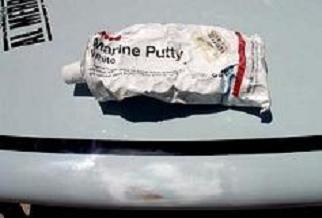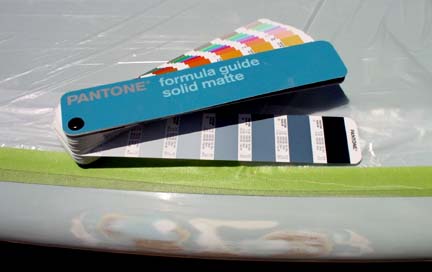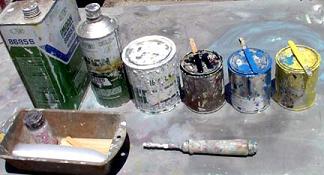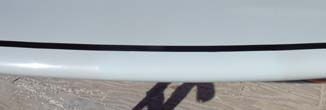|
| |
Paints & Painting
 |
General notes The harder the paint, the longer it will last, the more
expensive, and the more toxic. Wear a respirator!!
No matter how good you are, the sprayed-on paint will
always look better than the brushed-on.
Your paint job will only be as good as your prep work.
Prepping is 95% of the paint job.
A primer will reduce the chance of adverse paint
interaction. It will also show up any imperfections, so that you can touch up
the last pin holes etc before committing to the final paint.
Spending 10 minutes to mask off everything that is not
going to be painted will save you 1 hour later of not totally getting rid of the
overspray.
|
 |
The repair is filled, primed, sanded to
120grit, checked for pinholes, touched up with a glazing compound as needed
(shown 3M Acrylic), sanded again with 120, then 220, then cleaned.
From this point on, do not touch the site anymore with
bare hands, lest you leave oils or moisture or other contaminants behind
that would cause fish eyes or similar unpleasantness. |
 |
Anything within 3ft of the site is taped
off. If you use cheap masking tape, the paint will run under its edges. And
it will likely leave a sticky residue when you peel it off later. Pre-taped
masking film is a real timesaver! To match the
paint (especially greys!) I use a Pantone guide. No way could I actually
apply the
percentages listed (how many cc of yellow, if I am mixing 5cc altogether and
am supposed to use 1.7%? (the answer is .085 - I have no means of
measuring that)). But at least I can find out which basic colors need
to go in there. Big help, especially with greys! |
 |
All of this for a thimble full of grey
paint?? yup
Blend the color, then add converter, thinner etc exactly
as per directions on can (and if it recommends 1 drop of rocket fuel for
your batch size, DO NOT add 5!), dial in the proper pressure (you did drain
the compressor last night, right?)
put on the respirator |
 |
and apply paint
A light tack-coat to start, give it 30sec, then a wet
coat, wait 2mins, another wet coat, etc etc until full coverage is achieved,
which may take 4 or 5 coats, depending on the color and type of paint. If
you make each subsequent coat just a bit wider, you will end up with a nice,
soft edge. |
 |
Should a bug blunder into the wet paint,
or a piece of dust, or hair settle in your perfect paint job, pick it out
immediately with sharpened tweezers. Most small disturbances will flow out.
Some may need a little nudge with a touch-up brush, or a toothpick. Do not
give in to temptation and pile on more paint - you may well end up with a
run in addition to bugs wings... |
 |
Pull tape and masking film after about 1
hour
Let cure overnight, feather out with
400grit wet-and-dry, followed by 600, then 1200 grit. Finish by polishing. |
|
back to
Repair Menu |
|